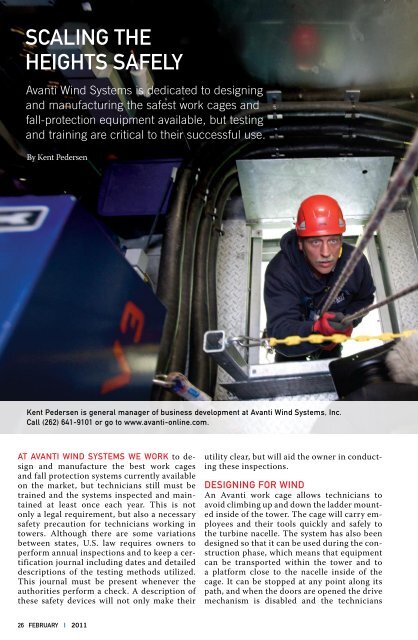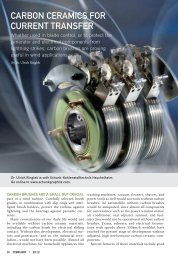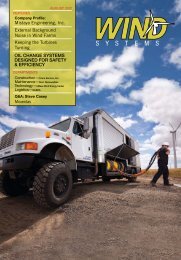Download PDF - Wind Systems Magazine
Download PDF - Wind Systems Magazine
Download PDF - Wind Systems Magazine
You also want an ePaper? Increase the reach of your titles
YUMPU automatically turns print PDFs into web optimized ePapers that Google loves.
ScAling thE<br />
hEightS SAFElY<br />
Avanti <strong>Wind</strong> <strong>Systems</strong> is dedicated to designing<br />
and manufacturing the safest work cages and<br />
fall-protection equipment available, but testing<br />
and training are critical to their successful use.<br />
By Kent Pedersen<br />
kent Pedersen is general manager of business development at Avanti <strong>Wind</strong> <strong>Systems</strong>, inc.<br />
call (262) 641-9101 or go to www.avanti-online.com.<br />
At AvAnti <strong>Wind</strong> SYStEmS WE WoRk to design<br />
and manufacture the best work cages<br />
and fall protection systems currently available<br />
on the market, but technicians still must be<br />
trained and the systems inspected and maintained<br />
at least once each year. This is not<br />
only a legal requirement, but also a necessary<br />
safety precaution for technicians working in<br />
towers. Although there are some variations<br />
between states, U.S. law requires owners to<br />
perform annual inspections and to keep a certification<br />
journal including dates and detailed<br />
descriptions of the testing methods utilized.<br />
This journal must be present whenever the<br />
authorities perform a check. A description of<br />
these safety devices will not only make their<br />
26 FEBRUARY | 2011<br />
utility clear, but will aid the owner in conducting<br />
these inspections.<br />
dESigning FoR <strong>Wind</strong><br />
An Avanti work cage allows technicians to<br />
avoid climbing up and down the ladder mounted<br />
inside of the tower. The cage will carry employees<br />
and their tools quickly and safely to<br />
the turbine nacelle. The system has also been<br />
designed so that it can be used during the construction<br />
phase, which means that equipment<br />
can be transported within the tower and to<br />
a platform close to the nacelle inside of the<br />
cage. It can be stopped at any point along its<br />
path, and when the doors are opened the drive<br />
mechanism is disabled and the technicians
can work safely from the cage or climb out<br />
onto the ladder. Most Avanti work cages can<br />
carry two technicians and their equipment,<br />
and they can be used in most types of turbine<br />
towers that have been prepared for them.<br />
Avanti engineers are constantly developing<br />
new work cage systems to meet all industry<br />
needs.<br />
Avanti <strong>Wind</strong> <strong>Systems</strong> has also developed a<br />
ladder system with a pre-mounted fall protection<br />
system. It is a statutory requirement<br />
that all ladders in wind turbine towers should<br />
be equipped with a fall protection system that<br />
prevents service technicians falling from the<br />
ladders if, for instance, they lose their footing<br />
or suddenly become ill. The fall protec-<br />
Fig. 1: Avanti climb assistance device.<br />
tion system stops the service technician after<br />
falling a few centimeters, and it remains locked<br />
until either the technician can continue alone<br />
or can be helped by colleagues. The system is<br />
based on a rail in the middle of the ladder. The<br />
service engineer’s harness is fitted with a clickon<br />
runner that then attaches to the rail. The<br />
runner is fastened to the engineer’s harness<br />
with a carabineer of the same type as used by<br />
rock climbers. The runner can be clicked onto<br />
the fall protection system anywhere on the ladder.<br />
As the Avanti fall protection system is designed<br />
with a fixed rail on the ladder, several<br />
technicians can use the system simultaneously.<br />
When using wire-based systems, a technician<br />
windsystemsmag.com 27
Fig. 2: the work cage can carry two technicians and their gear.<br />
28 FEBRUARY | 2011
must wait until his colleague<br />
has reached the nacelle before<br />
he can use the system himself.<br />
The Avanti system has been approved<br />
so that one technician<br />
can click onto the system every<br />
six meters. In other words,<br />
as soon as one technician is six<br />
meters up the ladder, the next<br />
one can start climbing.<br />
Avanti has also designed<br />
a system that makes it easier<br />
for technicians to climb towers.<br />
In simple terms, Avanti’s<br />
climb assistance is an endless<br />
rope that runs from the bottom<br />
to the top of towers. It is<br />
connected to a motor at the<br />
base of the tower, and here the<br />
engineer can set the system to<br />
a pull force between 30 and<br />
40 kilos. When the technician<br />
links to climb assistance with<br />
a rope grab and gently pulls<br />
the rope, the system takes up<br />
the selected bodyweight in<br />
kilos during the entire ascent<br />
and descent. If the technician<br />
stops climbing the system<br />
stops as well, and then starts<br />
again after a gentle pull of the<br />
rope. The system reduces the<br />
risk of injuries to engineers’<br />
knees, arms, shoulders, and<br />
feet.<br />
Avanti’s climb assistance<br />
can be installed in both new<br />
and existing towers. In fact,<br />
Avanti has installed many<br />
climb assistance systems in<br />
older towers throughout the<br />
world. Older turbines must<br />
be serviced more frequently,<br />
and this means many hard<br />
climbs for technicians on ladders.<br />
This is why many owners<br />
of older towers decide to<br />
install the new system. Climb<br />
assistance is not an anti-fall<br />
protection system, however. It<br />
is merely an aid for engineers,<br />
and it must always be used together<br />
with an approved antifall<br />
system. The independent,<br />
international test institute<br />
Force Technology has approved<br />
the simultaneous use<br />
of the two systems, as they<br />
function perfectly together.<br />
This is an additional guarantee<br />
of safety.<br />
PASSing thE tESt<br />
Our warranty for work cages, ladders, and climb assistance<br />
also requires test and inspection at least once each year by<br />
Avanti or personnel that we have trained. Turbine owners naturally<br />
accept that all the equipment in towers has to be correctly<br />
installed by authorized personnel. But a wind turbine<br />
tower is also a place of work, and in contrast to most other<br />
workplaces owners sometimes forget that safety equipment<br />
has to be tested regularly.<br />
As important as this testing is, proper training is also critical.<br />
Every year Avanti <strong>Wind</strong> <strong>Systems</strong> trains several thousand<br />
wind turbine industry employees throughout the world, either<br />
at the Avanti training centers or onsite at wind farms where<br />
the employees are working. It also provides closed courses<br />
for employees of the same company, or open courses in which<br />
anyone can participate. Not many people doubt the impor-<br />
windsystemsmag.com 29
Fig. 3: Rescue operation from outside of the tower.<br />
30 FEBRUARY | 2011<br />
tance of having effective<br />
safety equipment, but it<br />
is equally important that<br />
technicians working with<br />
the equipment are trained<br />
to work with it, and to deal<br />
with both dangerous situations<br />
and accidents.<br />
During the courses,<br />
which can run over several<br />
days, technicians learn<br />
everything about safety<br />
in relation to fire, evacuation,<br />
and rescue from towers.<br />
The courses include<br />
theory, but also rely heavily<br />
on practical exercises in<br />
towers. For example, one<br />
compulsory part of the<br />
course consists of a course<br />
member acting as if he is<br />
unconscious while his colleagues<br />
fasten him to the<br />
safety equipment from<br />
the rescue and evacuation<br />
unit, which must be in the<br />
nacelle, and then lowering<br />
first the unconscious subject<br />
and then themselves<br />
outside of the nacelle.<br />
This is a situation we<br />
hope will never occur in<br />
the real world, of course,<br />
but one that requires special<br />
training for any employee<br />
who may encounter<br />
such a challenge. It’s<br />
also important for owner’s<br />
to keep in mind that they<br />
are responsible for providing<br />
this training to anyone<br />
who will be relying on this<br />
safety equipment, and that<br />
the training must be kept<br />
current as well.<br />
thE AvAnti<br />
AdvAntAgE<br />
Founded in 1885 as the<br />
Avanti Ladder Factory in<br />
Denmark, scaling heights<br />
safely has been the company’s<br />
primary concern<br />
for more than a century.<br />
Avanti <strong>Wind</strong> <strong>Systems</strong> has<br />
designed work cages, ladder<br />
systems, and fall-protection<br />
devices specifically<br />
for wind technicians for<br />
the past 26 years. Today it<br />
is the world’s leading pro-
ducer of work cages and other<br />
personal safety systems for<br />
use in wind turbines, having<br />
supplied more than 12,000<br />
such devices all around the<br />
world, totaling more than<br />
half of all those installed.<br />
Avanti <strong>Wind</strong> <strong>Systems</strong> has<br />
recently begun production<br />
of ladder systems for wind<br />
turbines in the United States.<br />
Today the manufacturing of<br />
aluminium ladders is taking<br />
place near the company’s<br />
North American headquarters<br />
in New Berlin, which is<br />
close to Milwaukee, Wisconsin.<br />
The factory is intended<br />
to supply the North American<br />
wind market. Until now<br />
Avanti has manufactured its<br />
ladder systems in China and<br />
Germany, and these factories<br />
will continue manufacturing<br />
for the rest of the world.<br />
Avanti <strong>Wind</strong> <strong>Systems</strong> has<br />
also become a strategic distributor<br />
and service partner<br />
for Cresto ResQ products<br />
in the wind energy industry.<br />
Cresto—previously named<br />
ResQ—has sold more than<br />
25,000 sets of evacuation and<br />
rescue equipment for wind<br />
turbine towers around the<br />
world. The agreement between<br />
Avanti <strong>Wind</strong> <strong>Systems</strong><br />
and Cresto means that Avanti<br />
has established training and<br />
service centers for Cresto<br />
equipment in the United<br />
States, Germany, Great Britain,<br />
Spain, India, Australia,<br />
and China, where Avanti already<br />
has offices and factories.<br />
As with everything related<br />
to wind turbine tower<br />
safety, the evacuation equipment<br />
must be inspected and<br />
tested at least once each year.<br />
But Cresto has developed approved<br />
packaging that makes<br />
it possible to test the safety<br />
equipment just once in 10<br />
years. The safety equipment is<br />
vacuum packed—that is, put<br />
into a foil bag from which all<br />
the air is pumped out. When<br />
the rescue device, ropes, and<br />
other accessories are not in<br />
contact with oxygen and humidity they last longer, since the<br />
materials cannot wear down. The vacuum packing also safeguards<br />
the equipment against the wind turbine tower vibrations.<br />
What must still be tested each year in this instance is<br />
the integrity of the vacuum seal, in order to make sure that no<br />
equipment or mateiral degradation has occurred. If the packing<br />
is soft, it’s a sign of a hole in the bag, at which point everything<br />
will have to be inspected, tested, and vacuum-packed<br />
again.<br />
The Avanti-Cresto partnership also means that the two<br />
companies will jointly launch new series of harnesses and other<br />
personal protection equipment for technicians working on<br />
wind turbine towers. Safety has always been the top priority<br />
for Avanti <strong>Wind</strong> <strong>Systems</strong>, and the goal is clear: Safe work in<br />
wind turbines, anywhere in the world.<br />
windsystemsmag.com 31




